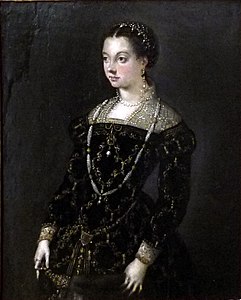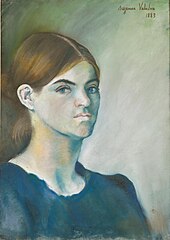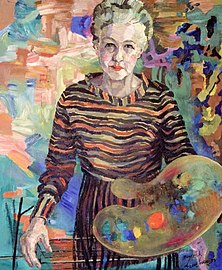Female self-portrait in painting
This article has an unclear citation style. (August 2024) |

Artemisia Gentileschi
Royal Collection
Female self-portrait in painting is the representation of a person of the female gender painted by herself.
While using pictorial techniques and responding to the motivations of the self-portrait in general, the female self-portrait differentiates itself from the male by aspects concerning the physiognomy, the anatomy and the physiology of the subject represented, or related to his psychology.
Place of the female self-portrait
The female self-portrait has long been considered a minor variety of portraiture. Of the famous collection of self-portraits exhibited in the Vasari Corridor in 1973, only 21 (5%) were by women[1]. In exhibition catalogues and works devoted to self-portraiture published between 1936 and 2016, most often signed by male authors, the place of the female self-portrait in painting is often even less than 5%[2][3][4][5][6][7], or 5 to 10%[8][9][10][11][12][13][14], sometimes from 10 to less than 20%[15][16][17][18][19][20]; however, a more recent work (2021) grants it almost parity[21].
It therefore appears that, depending on the era and the gender of the authors or curators of the exhibitions, the share of the female self-portrait in painting is evaluated in a very variable way; the recent increase is not the consequence of a renewed activity of the artists concerned, but that of a positive re-evaluation, from the 1970s, of the contribution of women in painting. Nevertheless, taking into account the fact that the female self-portrait appeared more than a century after the male self-portrait, and that for a long time there were fewer female artists, it would seem quite reasonable to place the proportion at a maximum of 15-20%. This figure is unlikely to change much in the future, as the self-portrait in painting has declined sharply during the 20th century, marked by new pictorial movements leading to what has been called the "disappearance of the figure", or "crisis of mimetic representation", and by the rise of photography and then digital art.[22][23][24][25][26][27].
The artists
The celebrities
The artists who appear in the "Top 5" of the works referenced above are Sofonisba Anguissola, Artemisia Gentileschi, Frida Kahlo, Angelica Kauffmann and Élisabeth Vigée Le Brun, followed by Rosalba Carriera, Lavinia Fontana, Paula Modersohn-Becker, Helene Schjerfbeck and Suzanne Valadon. Although they produced very few self-portraits, the impressionists Berthe Morisot and Mary Cassatt are often cited, as well as the pioneering Catharina van Hemessen and the iconic Tamara de Lempicka.[28]
The aristocrats
A singularity of the female self-portrait is to find artists from princely, royal and imperial families, mainly in the 17th and 18th centuries; while the sons of noble families are destined for war or the clergy, the girls receive a thorough artistic education, in music, literature and fine arts; equipped with this background, some have become accomplished painters. These include Ulrika Eleonora of Denmark, Anne de Hanovre, Countess Lulu von Thürheim, Leonor de Almeida Portugal, Marquise of Alorna, Princess Caroline Louise of Hesse-Darmstadt, Princess Caroline Louise of Hesse-Darmstadt, Princess Charlotte Bonaparte, Ernestine Charlotte of Nassau-Schaumburg, who portrays herself as Saint Casildan, Elisabeth Christine of Brunswick-Wolfenbüttel-Bevern as a gardener, Lady Diana Beauclerk as a Terpsichore, Louise Hollandine of the Palatinate as an allegory of painting, Amalia Wilhelmina von Königsmarck and Duchess Maria Antonia of Bavaria with palette and brushes.
-
Anne de Hanovre
1740 -
Duchess Maria Antonia of Bavaria, c.1772
Extreme ages
According to James Hall, Omar Calabrese, Whitney Chadwick or Martine Lacas, the self-portrait has often been a genre of young painters[29][30][31][32].
There are, however, notable exceptions. The longer life expectancy of women once the possible complications of childbirth have passed leads to the creation of female self-portraits at very advanced ages. While among men, Titian (78 years), Ingres (79 years), Claude Monet (77 years), Pierre Bonnard (78 years), Edvard Munch (80 years) and especially Picasso (90 years) are exceptions, among women there are many septuagenarians. The first being Sofonisba Anguissola, 78 years in 1610, author of about fifteen self-portraits over a period of sixty-five yearsn, and several octogenarians; Helene Schjerfbeck made about forty self-portraits, half of them in the two years preceding her death at the age of 83. When Rosalba Carriera depicted herself at the age of 71 as the muse of Tragedy — with a mask that was more melancholic than tragic — her personal tragedy was a progressive loss of vision, which would be operated on unsuccessfully three years later, leading to complete blindness. Among the painters at a very advanced age are Johanne Mathilde Dietrichson, aged 81 in 1918, Susan Macdowell Eakins, aged 84 in 1935, Mina Carlson-Bredberg, aged 81 in 1938, Vanessa Bell, aged 80 and 81 in 1959 and 1960; also in 1960, Charlotte Berend-Corinth, aged 80, and Émilie Charmy, aged 82; later, Lotte Laserstein aged 82 and 85, Marie Vorobieff aged 85 in 1977. After limiting her self-portraits to the body, Joan Semmel painted her face as an elderly woman in the series Heads in 2008. Adriana Pincherle painted herself in front of her easel aged 85, and, at 87, as a very elegant lady. Alice Neel, in 1980, painted a nude portrait of herself at the age of 80: "at least it shows a certain revolt against everything decent", she declared. Eve Drewelowe made her self-portrait entitled "Nonconformist" at the age of 85 (1984). Maria Lassnig, who painted herself nude on numerous occasions for over seventy years, produced her last self-portraits at the ages of 86 and 94, a year before her death in 2013 and/or in her mature years.[33][34][35][36][37]
-
Sofonisba Anguissola
age 78 -
Rosalba Carriera
age 71 -
Ottilie Roederstein
age 77 -
Johanne Mathilde Dietrichson
age 81 -
Helene Schjerfbeck
age 82 -
Helene Schjerfbeck
age 83 -
Eve Drewelowe
age 85
At the other extreme, we have some female self-portraits produced very early, such as the examples of the artists below:
-
Angelica Kauffmann
age 11, 1753 -
Anna Waser
age 12, 1691 -
Lucinda Redmon Orear
age 12, 1835 -
Teresa de Saldanha
age 13, 1851 -
Élisabeth Vigée Le Brun
age 16, 1771 -
Sofonisba Anguissola
age 18, c.1550 -
Marie Petiet
age 18, 1872
Attribution problems and the male ego
Schalcken's 1680 painting of a woman painting was attributed to Godfried Schalken before its restoration in the 20th century revealed the full signature, that of his sister Maria Schalcken. Often the daughters of painters, wives or sisters of painters, female artists have seen their work unrecognized or minimized - if not ridiculed or vilified - their talent denied or exploited, their careers forgotten and their names erased, often for the benefit of their male relatives, and also of more famous painters, this in greater or lesser good faith, or fraudulently, by forging a signature. A simple example among many others, when the portraits and self-portraits of Jacques-Louis David's female students were considered particularly successful, the teacher was suspected of being the author, and the false attribution was then adopted by posterity. The portrait signed "MDH Keane" (the initials "MDH" being those of her maiden name) was produced after the highly publicized lawsuit won by Margaret Keane in 1986 against Walter Keane over the authorship of all the paintings she had simply signed "Keane". This case is reminiscent of others, such as the paintings of Judith Leyster signed by Frans Hals, of Constance Mayer signed by Pierre-Paul Prud'hon... or simply the actions of Jean-Baptiste-Pierre Lebrun, a painter of no stature but an informed dealer, who sold the paintings of his wife Élisabeth Vigée Le Brun without her having the slightest idea of the fortune he had made from them and which he had lost in gambling. Even as an adult and later married, Marietta Robusti remained under the thumb of her father Tintoretto all her life, and was able to leave only very few paintings of her own. Problems of attribution also arise for Virginia Vezzi, wife and model of Simon Vouet, of whom there are at least one or two self-portraits.[38]
Money issues were not always the issue, but rather the most frequent problems of understanding between spouses. Louis Marcoussis having decided that only one cubist should exist in his couple, it was not he, but Alice Halicka who had to destroy some of his paintings; we still have her self-portrait from 1913. The same misfortune happened to Rita Angus, married at the age of 22 for a few years to the painter Alfred Herbert Cook, and who would go on to paint 55 self-portraits (“He didn’t like some of my paintings, and at his request I destroyed some works because I was his wife. And also, to have peace, I agreed to give up painting”), and certainly to several others.[39]
Like Paula Modersohn-Becker, the unhappy wife of the academic painter Otto Modersohn, Marie Bracquemond, an admirer of Renoir and Monet, was married to someone who did not appreciate her aesthetic aspiration, the artist Félix Bracquemond, a renowned engraver and ceramicist, vice-president of the Société Nationale des Beaux-Arts; of a touchy nature, he succeeded in making her abandon impressionism, and even all artistic production twenty years after her self-portrait as a young bride[40].
See also
References
- ^ Self-portraits of women in the Uffizi collections - Gallerie degli Uffizi
- ^ Frédéric Birr et Jean Diez (préf. Roger Garaudy), Les Peintres par eux-mêmes : de Giotto à Miró, Nouvelle Librairie de France, 1986, 207 p.
- ^ Ludwig Goldscheider, Fünfhundert Selbstporträts : Von der Antike bis zu Gegenwart, Vienne, Phaidon, 1936, 528 p.
- ^ Stéphane Guégan, Laurence Madeline, Thomas Schlesser et Henri Soldani, L'autoportrait dans l'histoire de l'art : de Rembrandt à Warhol, l'intimité révélée de 50 artistes, Beaux Arts, 2009, 255 p. (ISBN 978-2-84278-689-2)
- ^ Michelangelo Masciotta, Portraits d'artistes par eux-mêmes : xive – xxe siècle, Milan, Electa, coll. « Sphæra », 1955, 319 p.
- ^ Joëlle Moulin, L'autoportrait au XXe siècle : dans la peinture, du lendemain de la Grande Guerre jusqu'à nos jours, Adam Biro, 1999, 143 p.
- ^ Marie-Paule Vial, Claire Bernardi, Guillaume Ambroise et Guy Cogeval, Autoportraits, Paris, Flammarion/Musée d'Orsay, 2015, 128 p. (ISBN 978-2081370388)
- ^ Julian Bell (trad. Pierre Clertant et Erol Ok), 500 autoportraits, Paris, Phaidon, 2005, 548 p. (ISBN 978-0714893907)
- ^ Pascal Bonafoux, Les peintres et l'autoportrait, Genève, Skira, coll. « Le métier de l'artiste », 1984, 157 p. (ISBN 978-2605000395)
- ^ Pascal Bonafoux et Caroline Laroche, Autoportraits du XXe siècle, Paris, Gallimard, coll. « Hors série Découvertes », 2004, np (ISBN 978-2070313662)
- ^ Michael Koortbojian, Autoportraits, Paris, RMN, 1992, 64 p. (ISBN 2-7118-2533-7)
- ^ Sylvie Ramond et Stéphane Paccoud, Autoportraits : de Rembrandt au selfie, Cologne, Snoeck, 2016, 288 p. (ISBN 978-3-86442-140-2)
- ^ Ernst Rebel et Norbert Wolf (dir.), Autoportraits, Paris, Taschen, 2008, 96 p. (ISBN 978-3-8228-5461-7)
- ^ Agnès Rosenstiehl, Peintres : autoportraits, Paris, Autrement, 1997, 45 p. (ISBN 978-2862607344)
- ^ Anthony Bond, Joanna Woodall (en), T. J. Clark, Ludmilla Jordanova et Joseph Leo Koerner (en), Self Portrait : Renaissance to Contemporary, Londres, National Portrait Gallery Publications, 2005, 224 p. (ISBN 978-1-85514-357-9)
- ^ Pascal Bonafoux (dir.) et David Rosenberg, Moi ! Autoportraits du XXe siècle, Paris, Skira, 2004, 294 p. (ISBN 978-8884918543)
- ^ Yves Calméjane, Histoire de moi : histoire des autoportraits, Paris, Thalia, 2006, 251 p. (ISBN 978-2352780144)
- ^ Christian Demilly, Autoportraits, Palette, 2010, 72 p. (ISBN 9782358320153)
- ^ Philippe Renard, Portraits et autoportraits d'artistes au XVIIIe siècle, Tournai, La Renaissance du Livre, coll. « Références », 2003, 189 p. (ISBN 978-2804608163)
- ^ Liz Rideal (en) et Julian Bell (trad. Pierre Clertant, Jean-Bernard Gouillier et Erol Ok), 500 autoportraits, Paris, Phaidon, 2018, 587 p. (ISBN 978-0714876214)
- ^ Natalie Rudd (trad. Camille Fort), L'autoportrait, Paris, Flammarion, coll. « L'art en poche », 2021, 171 p. (ISBN 978-2-08-023691-3)
- ^ Linda Nochlin, « Why Have There Been No Great Women Artists [archive] » [« Pourquoi n'y a-t-il pas eu de grandes artistes femmes ? »], ARTnews, janvier 1971 (consulté le 4 octobre 2022), p. 22
- ^ Anne Sutherland Harris et Linda Nochlin (trad. Claude Bourguignon, Pascale Germain, Julie Pavesi et Florence Verne), Femmes peintres 1550-1950, Paris, des femmes, 1981, 366 p. (ISBN 9782721002082)
- ^ Marie-Jo Bonnet, Les Femmes dans l'art : Qu'est-ce que les femmes ont apporté à l'art, Paris, La Martinière, coll. « Patrimoine », 2004, 256 p. (ISBN 978-2732430874)
- ^ Laure Adler et Camille Viéville, Les femmes artistes sont dangereuses, Paris, Flammarion, 2018, 159 p. (ISBN 978-2-0814-1628-4)
- ^ Lucinda Gosling, Hilary Robinson et Amy Tobin (trad. Caroline de Hugo), L'Art du féminisme : les images qui ont façonné le combat pour l'égalité, 1857-2017, Paris, Hugo Image, 2019, 272 p. (ISBN 978-2755641189)
- ^ Katy Hessel (trad. Anna Souillac et Aurélien Blanchard), Histoire de l'art sans les hommes, Paris, Michel Lafon, 2022, 512 p. (ISBN 978-2-7499-5138-6) « Lady Diana Spencer, autoportrait en muse Terpsichore
- ^ 10 Most Famous Self-Portraits by Female Artists - DailyArt.
- ^ Omar Calabrese (it) (trad. Odile Ménégaux et Reto Morgenthaler), L'art de l'autoportrait : histoire et théorie d'un genre pictural, Paris, Citadelles & Mazenod, 2006, 390 p. (ISBN 2-85088-117-1), chap. 7 (« Questions de genre. Les femmes et l'autoportrait »), p. 214-247
- ^ Liz Rideal (en) (dir.), Whitney Chadwick (en) (essai : How Do I Look ?, p. 8-21) et Frances Borzello (en)(essai : Behind the Image, p. 22-31), Mirror Mirror : Self-portraits by women artists, New York, Watson-Guptill, 2002, 120 p. (ISBN 978-082303071-2) and/or in maturity
- ^ Omar Calabrese, L'Art de l'autoportrait, p. 220
- ^ Martine Lacas, Des femmes peintres, p. 79
- ^ Élisabeth Lebovici, Béatrice Parent (dir.) et Suzanne Pagé (dir.) (pref. Bernard Arnault), Les clefs d'une passion : Helene Schjerfbeck, Paris, Hazan, 2015, 287 p. (ISBN 978-2754108324)
- ^ Autoportraits : de Rembrandt au selfie, Cologne, Snoeck, 2016, 288 p. (ISBN 978-3-86442-140-2), « Pourquoi fait-on des autoportraits ? », p. 12-21
- ^ Liz Rideal. Mirror Mirror, p. 12
- ^ Omar Calabrese. L'Art de l'autoportrait, p. 220
- ^ Martine Lacas. Des femmes peintres, p. 79
- ^ Yaelle Arasa, Davidiennes : Les femmes peintres de l'atelier de Jacques-Louis David (1768-1825), Paris, L'Harmattan, 2019, 209 p. (ISBN 978-2-343-17028-2), « Autoportrait », p. 62-68
- ^ Jennifer Higgie, The Mirror and the Palette : Rebellion, Revolution and Resilience : 500 Years of Women's Self-Portraits, Londres, Weidenfeld & Nicolson, 2022 (1re éd. 2021), 328 p. (ISBN 978-1-4746-1379-8)
- ^ Laurent Manœuvre, Les pionnières : femmes et impressionnistes, Rouen, Éditions des Falaises, 2019, 207 p. (ISBN 9782848114064), « Marie Bracquemond », p. 24-27















![Ulrika Eleonora of Denmark[n.d.]](/upwiki/wikipedia/commons/thumb/b/bc/Selfportrait_%28Drottning_Ulrika_Eleonora_d.%C3%A4.%29_-_Nationalmuseum_-_24027.tif/lossy-page1-228px-Selfportrait_%28Drottning_Ulrika_Eleonora_d.%C3%A4.%29_-_Nationalmuseum_-_24027.tif.jpg)





















